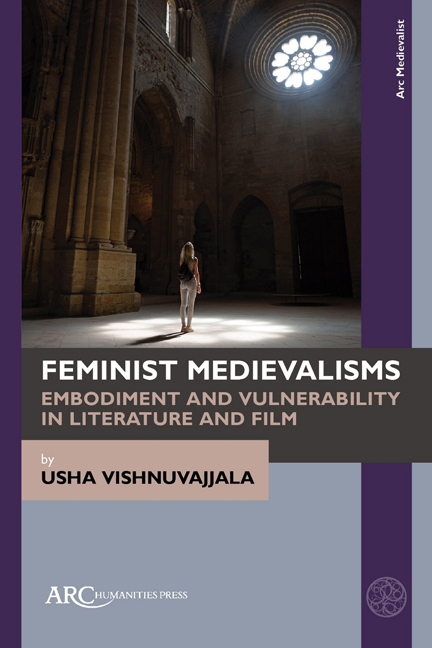Book contents
- Frontmatter
- Contents
- Acknowledgements
- Introduction
- Chapter 1 Nested Medievalisms and Affected Bodies in Jane Austen’s Northanger Abbey
- Chapter 2 Feminism and Medievalism in Woolf’s Final Works
- Chapter 3 Medievalism as Feminist Sanctuary in the late Twentieth Century
- Chapter 4 Chaucer, Vulnerable Bodies, Somatophobia, and Theory
- Conclusion: Feminisms and Medievalisms
- Select Bibliography
- Index
Chapter 1 - Nested Medievalisms and Affected Bodies in Jane Austen’s Northanger Abbey
Published online by Cambridge University Press: 28 March 2024
- Frontmatter
- Contents
- Acknowledgements
- Introduction
- Chapter 1 Nested Medievalisms and Affected Bodies in Jane Austen’s Northanger Abbey
- Chapter 2 Feminism and Medievalism in Woolf’s Final Works
- Chapter 3 Medievalism as Feminist Sanctuary in the late Twentieth Century
- Chapter 4 Chaucer, Vulnerable Bodies, Somatophobia, and Theory
- Conclusion: Feminisms and Medievalisms
- Select Bibliography
- Index
Summary
THE MEDIEVALISM in Jane Austen’s novels has not been a major concern for either medi evalism scholars or Jane Austen scholars. But scholarly work on Austen has become increasingly interested in her politics and in how she situated her novels among prevailing ideas of history. The idea that Austen was not politically engaged has gradually given way to the current near-consensus that she was aware of and possibly interested in abolitionist politics, and recent scholarship has revisited her portrayal of Northanger Abbey heroine Catherine Morland as uninterested in history to suggest that it is documented history, not Catherine, at whom Austen is poking fun.
Austen was writing before the word “medieval” was in popular use, and very shortly before Walter Scott and others made overtly medievalist novels a popular mode of nineteenth-century fiction, but she was also engaged with different writing traditions that had ideas about the Middle Ages and their reception at their centre. Most notably, of course, she read, was influenced by, and critiqued Gothic fiction, especially the novels of Ann Radcliffe, and Northanger Abbey does often come up in conversations about medievalism because of its focus on the Gothic. The medievalism that interests me in Northanger Abbey is therefore not a direct one—rather than engaging explicitly with medieval culture, Austen most often engages with novels that themselves depict a sort of haunting of early modern culture by medieval culture. That might seem to make the medievalism of this novel tenuous. But I will argue in this chapter that Austen is not merely commenting on uses of the medieval, she is situating her narrative, especially the second half of the novel, within what I call a nested medievalism, which requires the peeling back of multiple layers to find what is or isn’t present at their centre. She does so after establishing, in the first half of the novel, that appeals to the medieval serve very different purposes for the novel’s hero, Catherine Morland, than they do for the predatory male characters whose nefarious motives are eventually uncovered. This bifurcation in the ways the novel’s characters participate in or use medievalism establishes that the value of medievalism has more than one register in the novel, and that, for Austen, these different registers are also ethically divergent.
- Type
- Chapter
- Information
- Feminist MedievalismsEmbodiment and Vulnerability in Literature and Film, pp. 19 - 44Publisher: Amsterdam University PressPrint publication year: 2024



